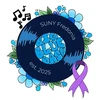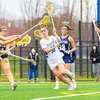|
|
A SUNY Fredonia College of Education professor and her graduate student have written two companion guides to accompany the teaching of a new biography on Robert H. Jackson.
Jackson, the former Supreme Court Justice and lead prosecutor in the Nuremberg war trials which convicted many prominent leaders of Nazi Germany after its defeat in World War II, was a native of Jamestown, N.Y.
The new literary guides are intended to play an integral role in Chautauqua County classrooms when students learn about this local historical figure.
Dr. Cindy Bird, assistant professor of Literacy, and Matthew Kindberg, an area high school teacher pursuing a master’s degree in Literacy, produced reader’s and teacher’s guides to accompany Gail Jarrow’s “Robert H. Jackson: New Deal Lawyer, Supreme Court Justice and Nuremberg Prosecutor.”
An award-winning author based in Ithaca, N.Y., Ms. Jarrow wrote the historical biography of the relatively unknown justice in student-friendly language for a new generation of Americans.
The genesis for the publications was Randy Gadikian, director of SUNY Fredonia’s Daniel Reed Library and chairman of the Chautauqua/Cattaraugus Big Read, a community initiative that promotes reading literature for intellectual and social discourse. During last year’s inaugural Big Read, organizers established partnerships with several community organizations, including the Robert H. Jackson Center in Jamestown. That relationship prepared the groundwork for the two Jackson biography guides.
Dr. Bird was initially contacted by Mr. Gadikian last February to author the guides. A specialist in Adolescent Literacy and teacher of graduate students — including several already working as teachers in area schools — Bird immediately recognized the merits of having a grad student join such a meaningful project as co-author. Without hesitation, she identified Mr. Kindberg, who earned an undergraduate degree in 2006 from SUNY Fredonia and currently teaches Social Studies at Clymer Central School, as an outstanding choice to assist.
“When I told (Randy) I had a graduate student who was a Social Studies teacher and a Jamestown fellow, the fit seemed perfect,” Bird recalled.
Both brought valuable skills to the project. Bird had extensive curriculum knowledge and writing skills. As expected, Kindberg offered considerable Social Studies and history knowledge, but Bird quickly recognized that his viewpoint from the classroom would serve as one of his most significant contributions.
“As a Social Studies teacher in Chautauqua County, Matthew was the audience for our teacher guide; he embodied the readership that would actually be using the guides in the classroom,” Bird explained. “So if Matthew felt good about something, we kept it; if he was unsure or unhappy, we changed it,” she remarked.
The guides, both 16 pages in length, are divided into five sections: Jackson’s Early Years in Chautauqua County; Jackson’s Work in Washington; Jackson at Nuremberg; Jackson on the United States Supreme Court; and Jackson’s Impact and Influence. Bird and Kindberg each wrote their own sections, and then combined them into the full guides.
Design and actual layout of the publications was performed by another SUNY faculty member, Janet Conradi, associate professor of Graphic Design. Formerly an art director with an Iowa publishing house, Ms. Conradi praised the two authors for their enthusiastic vision for the project and considerable effort to develop thought-provoking content. “Our team had the shared goal of providing substantive learning materials to entice an audience of young readers,” she said.
The reader’s guide, dedicated to future public speakers, writers and lawyers, offers self-directed learning to accompany the reading of Jarrow’s book. Each section contains discussion questions designed to help with comprehension of the biography, along with ideas for further exploration to link the topic to current times.
The teacher’s guide is dedicated to all teachers and educators who wish to develop a sense of history, civics and social justice within their students. It provides a focus for each section, includes possible responses to the reader’s discussion questions, and lists additional materials and activities for further exploration.
“Dr. Bird and I provided each other with helpful suggestions on content and voice, and advice on what to include for activities in each other’s sections,” Kindberg explained. “We wanted to be sure that the language would not be too ‘university’ for grade 8 students, and that the suggested activities would be helpful for the teachers but also meet New York State standards for Social Studies.”
The writing duo made several trips to Jamestown’s Jackson Center to obtain photographs for use in the guides, to examine archives and also interview the center’s director, Adam Bratton, and office manager Carol Drake. They also met with Jarrow.
The writing and drafting processes, Kindberg says, offered a tremendous learning experience, and he also gained a new appreciation for page layout and deadline details. Drawing upon his own classroom experiences, he generated a steady stream of ideas and made wide-ranging contributions as the project took shape. Bird, meanwhile, helped keep the guide focused by asking the question: “What would be the benefit for the student or teacher” of including certain facts or asking certain questions.
Although Kindberg grew up in Jamestown, he knew little about Jackson before beginning the project. Now, however, he has gained a deep appreciation for his legacy.
“Not only was I able to take what I was researching and writing about and apply it directly to my classroom, but I got the great satisfaction of knowing that my writing would also help other Social Studies teachers in Chautauqua County to teach about this great man,” he said.




